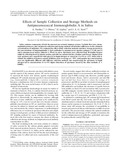| dc.description.abstract | Saliva contains components of both the mucosal and systemic immune systems. Variable flow rates, immunoglobulin proteases, and variation in collection and storage methods all introduce differences in the estimated concentrations of antibodies. We evaluated the effect of four collection methods and three storage protocols on the concentrations of immunoglobulin A (IgA) antibodies to pneumococcal capsular antigens 1, 5, 6B, and 14 and to pneumococcal surface adhesin A (PsaA) in saliva. Specimens were collected from 30 healthy Kenyan adults by collecting drool, by pipette suction, and with two commercial kits, OraSure and Oracol. Aliquots from each specimen were snap-frozen with glycerol in liquid nitrogen or stored for 4 to 8 h at +4°C either with or without the addition of protease enzyme inhibitors prior to storage at −70°C. Anticapsular IgA concentrations were not significantly different with different collection methods, but snap-freezing the specimens in liquid nitrogen led to concentrations 41 to 47% higher than those of specimens stored by the other methods (P < 0.0005). | en_US |

